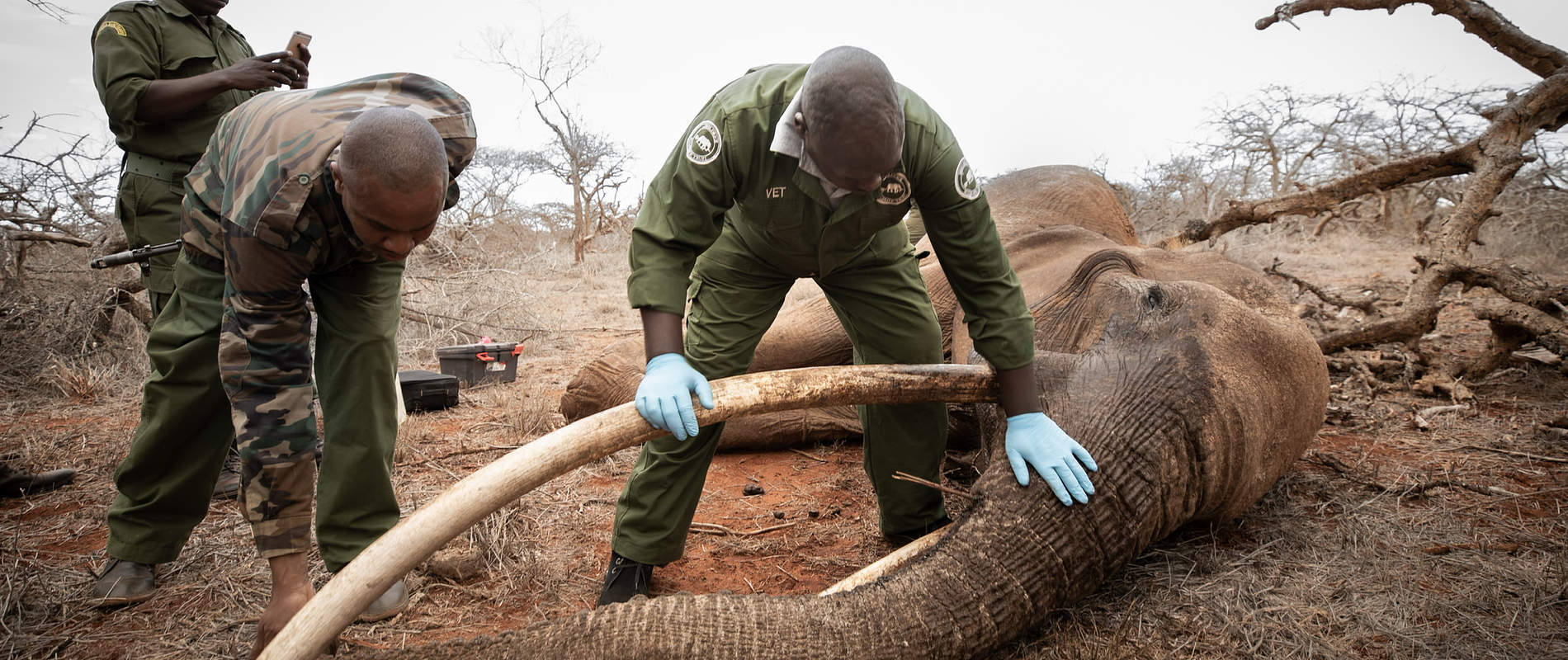August ended with a veterinary marathon. The day began with a stately elephant mum who had been arrowed, but then came two surprise patients. By the time the team was done, three generations of elephants had been saved — all of whom had been harmed by the human hand.

On the afternoon of 31st August, we received reports of a large female who had an arrow sticking out of her trunk. She was located on Rukinga Ranch, a vast wilderness bordering the southern edge of Tsavo. The female is well-known to those who work in the landscape; her long, slender tusks belie decades of wisdom.

Patient One, an elephant mum who had been arrowed in the trunk
A single arrow threatened to unravel all that. Further raising the stakes, she had an 18-month-old calf by her side. At such a young age, the baby was milk-dependent and entirely reliant on his mother’s care. Anything that put her life at risk jeopardised his future, too.

Our helicopter collected Dr Limo of the SWT/KWS Tsavo Mobile Vet Unit and flew him to the scene. Mid-flight, they received the first curveball: A three-year-old calf had been spotted with a cable snare around her neck. She was also located on Rukinga Ranch, not far from the original patient.

But first, we had a mother elephant to save. The helicopter and the team converged to make a treatment plan. Dr Limo decided to dart her from the ground, while the helicopter remained on standby in case aerial support was needed.

As it transpired, it was needed quickly. The moment the patient succumbed to the anaesthetic, her calf took off into the bushes. The helicopter gently shepherded the baby from the air, ensuring it didn’t stray too far from the scene. Two Wildlife Works gyrocopters provided additional aerial support, keeping eyes on the second snared patient to ensure she didn’t disappear.

Patient Two, a calf with a cable snare around her neck
Treatment was fairly straightforward for the first patient. The arrow wasn’t poisoned, which indicates that it was likely the result of human-wildlife conflict. After removing it, the team thoroughly cleaned the entry site and administered long-lasting antibiotics to expedite recovery. They then turned their attention to a suspect scar on her side. As it turned out, this was another arrow wound, but it was quite old and had fully healed, so further treatment was not necessary.

After the anaesthetic reversal was administered, the female struggled to stand, so the team walked over to give her an assist. As soon as they approached, however, she shot to her feet – sending her would-be rescuers seeking cover in the nearest trees! Meanwhile, the helicopter pushed her calf ever closer, so he could find his way to her side. We can only imagine mother and baby’s relief to be reunited.

With the first patient successfully sent on her way, the team embarked on the second treatment of the day. After seven-minutes in the air, the helicopter located the three-year-old snare victim. Significantly complicating matters, she was amidst a herd of 15 elephants. One of those elephants was undoubtedly her mother — and given the calf’s age, she would be very protective, meaning we would have to dart mother and baby — but we couldn’t definitively establish her identity.

As the helicopter team scoured the herd for the mother, they noticed a third elephant who needed help: A young female in her early teens with an arrow wound on her bum.
It was time to adjust our strategy. To mitigate the risk of one patient running off with the herd while the other was being treated, Dr Limo decided to dart both elephants at the same time. They went down within a few minutes of each other, while the helicopter pushed the rest of the herd a safe distance away. This included the snared youngster’s mother, whose identity remained a mystery.

Patient Three, a teenager with a poisoned arrow wound on her bum
First up was the snared calf. The team cut away the thick cable wire encircling her neck and then treated the resultant wound. While the snare had sliced deep into the skin, it hadn’t cut any vital organs, so Dr Limo is confident she will make a speedy recovery.

Meanwhile, a splinter team started treating the arrowed teenager, who had dropped about 100 metres away. As soon as the snared calf was revived, Dr Limo ran over to her side. This female was lucky to have been spotted: Unlike the first patient, she had been struck with a poisoned arrow — which, left untended, could have had fatal consequences. Fortunately, the poison hadn’t yet done its lethal work. With the arrow removed and the wound treated, she was sent on her way with a positive prognosis.

All three patients had been treated, but our work was not yet done. The snared calf was a few kilometres away from her herd. Wildlife Works provided an aerial assist, shepherding the herd back to her side. Everyone reunited with a happy chorus of trumpets and rumbles, before disappearing into the wilderness.

These elephants are at very different stages of life. One is a mother, trying to raise her calf through a difficult drought. One is a teenager, likely on the cusp of motherhood herself. One is just a baby, with her whole future ahead of her. Two arrows and a snare threatened to cut all that short. Fortunately, because of quick intervention and field-level teamwork, all three have their lives back.
